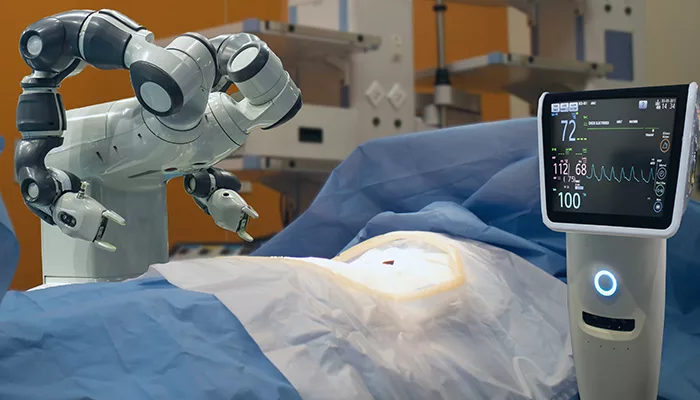Robo navigation technology- How Technology Is Transforming Orthopedics
September 4, 2020
Robotic Navigation is a highly advanced field that includes a robot to be able to determine its position according to a given frame of reference and then plot a path towards the desired location. This technology has been used in navigation systems, self-driving cars, etc. And now this technology has started to find its use in the medical field as well. It is now used for improved patient care, waste reduction, and cost savings.
The da Vinci surgical system was the first FDA approved, robot-assisted surgery platform. Since then, robotics have come a long way and found its use in different procedures like gynecology, cardiac, urology, and orthopedic surgeries.
When it comes to orthopedic surgery, robots are used for performing the tasks that require extreme precision like preparing the bony surfaces, placing the artificial implants, etc. For example, in the joint replacement surgery, the damaged part of the body needs to be removed. The robotic arm is used during the procedure to make sure that only the damaged part is removed. Then, it is used to correctly place the artificial joint. The arm provides auditory, visual, and tactical assistance to get the desired orientation of the implant.
Here is how robotics is used in the orthopedics to give better, improved results:
- Stryker - Robot-Assisted Knee and Hip Surgery System
The world’s largest device company for orthopedics, Stryker is planning to double its growth in Mako systems for robot-assisted hip and knee surgery. The Mako system will develop a 3D structure of the patient’s joint giving the surgeon an opportunity for evaluating the structure of the bone, alignment of the joint and the surrounding tissues. It will also provide real-time data of the motion’s range during the surgery. A robotic arm is used to remove the cartilage and bone and replace it with an implant.
- Zimmer Biomet - Robotic-Assisted Knee and Spinal Surgery Platforms
Zimmer Biomet got the FDA clearance of using a surgical navigation system known as ROSA ONE Spine. This system helps the surgeons perform complex and minimally invasive spine procedures with ease. Zimmer is the first organisation to offer brain, knee, and spine surgeries using the same platform. The platform provides live data on bone and tissue anatomy during the surgical procedure. This significantly increases the accuracy of the bone cutting and range of motion analysis.
- Smith & Nephew - Software for Its Hand-Held Robotic Surgical System
When it comes to knee implants, Smith & Nephew are considered to be the global leader. Recently, they introduced a new system called Navio 7.0 that has a latest interface, a streamlined workflow, and an expanded preference for surgical procedures. These changes are supposed to significantly reduce the time of surgery. They are also working on a new platform that will incorporate machine learning technologies, robotic arms, and augmented reality.
- Medtronic - The Mazor X Stealth Robotic-Assisted Spinal Surgical Platform
Mazor Robotics developed a robotic-assisted surgery platform that was purchased by Medtronic in 2018 for $1.7 billion. The platform uses software to help the surgeons plan the spinal surgery. It also visualizes the entire procedure including the trajectory of every single screw. To ensure that the procedure is carried out accurately and efficiently, the platform provides real-time imaging to the surgeons.
- Johnson & Johnson - Robotic-Assisted Surgery Platform in Development
Johnson & Johnson bought Orthotaxy which is robotic-assisted surgery company based in France. It is planning to expand its technology from knee replacements to other orthopedic surgeries. They aim to personalize their platform according to individual patients to provide better outcomes and value to their orthopedic procedures.
Benefits of Robotic Surgery
Robotic surgery is still finding its applications in different surgical procedures but it has found to have the following benefits for every procedure:
- Joint or screws can be places with improved accuracy.
- Surgeries are now minimally invasive that leads to reduced stay at the hospital.
- Since the procedures are precise, there are reduced readmissions and fewer revision procedures.
- Less manual effort in the procedure has resulted in cost savings.
- The operating time has reduced.
- Infection rates have gone significantly lower.
- There is reduced exposure to radiation.
- Pain and scarring have decreased.
Our Doctors
DR. YUGAL KARKHUR
MBBS,MS,DNB...
| Experience | : | 6 Yeras Experience |
|---|---|---|
| Speciality | : | Orthopaedics and Tra... |
| Location | : | Sector 8 |
| Timings | : | Mon/ Wed/ Fri : 11:0... |
DR. HIMANSHU KUSHWAH
MBBS, DIP IN ORTHO...
| Experience | : | 5 Yeras Experience |
|---|---|---|
| Speciality | : | Orthopaedics and Tra... |
| Location | : | Vikas Nagar |
| Timings | : | Mon - Sat : 10:00 AM... |
DR. SALMAN DURRANI
M.B.B.S, DNB (Orthop...
| Experience | : | 15 Yeras Experience |
|---|---|---|
| Speciality | : | Orthopaedics and Tra... |
| Location | : | Sector 8 |
| Timings | : | Thur - 10:00AM to 2:... |
DR. ALBERT DSOUZA
MBBS, MS (Ortho)...
| Experience | : | 17 Yeras Experience |
|---|---|---|
| Speciality | : | Orthopaedics and Tra... |
| Location | : | NSG Chowk |
| Timings | : | Tue, Thur & Sat : 05... |
DR SHAKTI AMAR GOEL
MBBS, MS (ORTHOPAEDI...
| Experience | : | 10 Yeras Experience |
|---|---|---|
| Speciality | : | Orthopaedics and Tra... |
| Location | : | NSG Chowk |
| Timings | : | Mon & Wed : 04:00 P... |
DR. ANKUR SINGH
MBBS, D.Ortho, DNB -...
| Experience | : | 11 Yeras Experience |
|---|---|---|
| Speciality | : | Orthopaedics and Tra... |
| Location | : | NSG Chowk |
| Timings | : | Mon - Sat : 10:00 A... |
DR. CHIRAG ARORA
MBBS, MS (ORTHO)...
| Experience | : | 10 Yeras Experience |
|---|---|---|
| Speciality | : | Orthopaedics and Tra... |
| Location | : | Sector 8 |
| Timings | : | Mon - Sat : 10:00 A... |
DR. SRIDHAR MUSTHYALA
MBBS...
| Experience | : | 11 Yeras Experience |
|---|---|---|
| Speciality | : | Orthopaedics and Tra... |
| Location | : | Ameerpet |
| Timings | : | Mon - Sat : 02:30 P... |
DR. A SHANMUGA SUNDARAM M.S.
MBBS, MS (Ortho), MC...
| Experience | : | 18 Yeras Experience |
|---|---|---|
| Speciality | : | Orthopaedics and Tra... |
| Location | : | MRC Nagar |
| Timings | : | Mon - Sat : On Call... |
DR. NAVEEN CHANDAR REDDY MARTHA
MBBS,D'Ortho,DNB...
| Experience | : | 10 Yeras Experience |
|---|---|---|
| Speciality | : | Orthopaedics and Tra... |
| Location | : | Ameerpet |
| Timings | : | Mon - Sat : 9:00 AM ... |
NOTICE BOARD
CONTACT US
CONTACT US
 Book Appointment
Book Appointment






.jpg)




.svg)
.svg)
.svg)
.svg)








